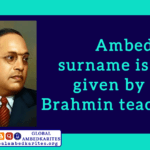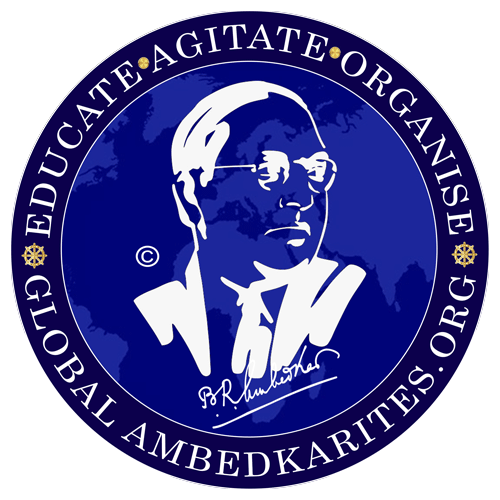
1. Dr. Ambedkar’s father adopted the surname Ambedkar and it wasn’t given by Bhimrao Ambedkar’s teacher as is commonly believed.. In volume 10 page 3 of Dr Bhimrao Ambedkar’s works and speeches, his father’ name is written as Subedar Major Ramji Maloji Ambedkar. (Are there any surviving Brahmins with the surname Ambedkar? If no, doesn’t this indicate that Ambedkar is not a Brahmin surname?).
2. Dr. Ambedkar was the only person who fought for the freedoms of ALL Indian regardless of race, creed, gender or caste from all oppressors. He thus ensuring human rights and social justice for all females, workers, children, disabled, downtrodden, the mentally crushed and broken. (What are the contributions of Dr. B. R. Ambedkar towards India?)
3. According to Dr.Ambedkar, cultivation and expansion of mind should be the ultimate aim of human existence and equality, liberty, fraternity, justice should be the ultimate aim of society we live in. Both compliment each other BUT Neither is possible unless a belief in jati system is annihilated first
4. Many know Dr.Ambedkar to have written several volumes of works. The lesser known fact is that he was also a lexicographer and compiled a Pali/English dictionary
5. Dr. Ambedkar had started four editorials to spread his ideology.
6. He organized the famous Mahad satyagraha as soon as he took charge as member of Bombay legislative assembly.
7. His first temple entry movement was the Kalaram temple entry movement.
8. Dr.Ambedkar refused to sign the temple entry bills (Ranga Iyer and Subbarayan bills).
9. Even though Dr.Ambedkar was for the temple entry (during the initial stage) he found large amounts of money used for worship as a complete wastage.
10. It is only because of Dr. Ambedkar that the untouchables were politically recognised after 2500 years!!!!!!.
11. 4th April birthday of the icon is celebrated as World’s Knowledge Day.
12. He is considered as the symbol of knowledge and Columbia university conferred upon Dr.Ambedkar the title, “Father of Modern India”
13. Dr.Ambedkar was a great musician too. His favorite instruments were the tabla and violin.
14. He owned the world largest personal library (at the time of his death). The number of books the doctor owned was estimated to be around 50,000. That is, despite the sinking of a cargo ship transporting his books from England.
15. Dr. Ambedkar refused to and did not draft article 370 of the Indian constitution regarding Kashmir.
16. He won with a thumping majority in the 1937 elections.
17. He fought for the khoti system.
18. Most of the time Dr. Ambedkar could be found reading and he often enjoyed a stroll along book markets.
19. He was suspected as a revolutionary by Dwyer
20. He defended the famous Chirner firing case and saved many freedom fighters
21. Dr. Ambedkar won separate electorate for the untouchables and low castes as was granted to the Sikhs, Muslims and Anglo-Indians. The reservation system, solely but falsely blamed by many on Dr. Ambedkar, is instead a result of Mr Gandhi’s opposition to seperate electorate for the most deserved. In protest Gandhi vowed a fast unto death.
22. At a tender age of 24, Dr.Ambedkar published the article “Caste their Genesis and mechanisms” and challenged known scholars on the castes system, in those days
23. Dr.Ambedkar did not burn the manusmriti. The Draconian law book was burnt by a Brahmin SAHASRABUDDHE . Dr. Ambedkar along with people of various castes, including the Brahmins, were present at the burning. ( What was Dr. B.R. Ambedkar’s reasoning behind burning the ‘Manusmriti’? and Shekhar Bodhakar’s post in GLOBAL AMBEDKARITES)
24. Dr.Ambedkar wrote a book on army. However, the work remained incomplete.
25. Dr.Ambedkar was only on his twenties when he participated in the Southborough comittee.
26. In addition to the two PhD degree obtained from the world prestigious universities, Dr. Ambedkar was awarded two more honoris PhD awards by Osmania University and Columbia university.
27. His interest in Buddhism crystallized when Dr. Ambedkar was still at school.
28. By the year 1936, Dr.Ambedkar openly started encouraging the untouchables to leave the Hindu fold.
29. Dr. Ambedkar had also looked at Sikhism as a possible choice of conversion.
30. Political parties started by Dr. Ambedkar were the Depressed Classes Federation (DCF) in 1930 and the Independent Labour Party (ILP) in 1935. He also formed an organization known as Scheduled Castes Federation (SCF) to campaign for the rights of the depresses classes.
31. Dr.Ambedkar suggested that the deprived and depressed class be referred to as ‘Protestant Hindus ‘ or ‘non-conformist Hindus’.
32. Dr. Ambedkar opened a college named Siddharth.
33. Dr. Ambedkar eagerly read communist literature and had a deep understanding of it more than most communists
34. When Bhagat Singh had thrown bombs in the assembly in support of Bombay workers strike, Dr. Ambedkar was against the strike as it was used by the union leaders for their benefits.
35. He was a good cook too. From a young age, he used to cook pulav regularly.
36. He was fluent in many Indian and foreign languages.
37. He was a lover of dogs. He cried for long periods when his pet dog died.
38. During his last days he did not have enough money to publish his masterpiece “The Buddha and his Dhamma”.
39. He sympathized with Bhagat Singh and Co by publishing an article about them in his editorial “The Janata”.
40. 1st April is celebrated as “Indian Economics Day” (or RBI foundation day), as on this day the Reserve Bank of India was established based on the works of Dr.Ambedkar
41. Even as late as the year 1946, Dr.Ambedkar was not allowed to enter Puri temple on account of his untouchability.
42. His life had always been in danger by fellow Indians themselves. Around the year 1940 his editorial office was burnt in an arson attack.
43. Dr. Ambedkar, with his great reasoning power had won most of the debates at the Round Table conference. His debate with Winston Churchill was considered the best. He was the first person at the Round Table Conference to have demanded complete freedom with no influence from the British. Mr Gandhi appeared in the second conference and was satisfied with British dominion and Princely states.
44. He cried heavily when told he may not be able to read further due to problems with his eyesight.
45. It is also in records that Dr.Ambedkar used to render help to the common man unknown to him, even at inconvenient hours of the day.
46. Dr. Ambedkar was a teetotaler.
47. Many know that he drafted the world’s largest constitution in record time but the fact that he was physically unfit during it’s drafting remains untold.
48. His favourite song was “Buddham Saram Gucchami”. The icon was found singing this song before he attained eternal bliss. A video of this song is composed in a not so well known music traditions, “Theravi music”. It can be found in the link ( What facts will completely change your perception about Dr B. R. Ambedkar?).
49. Dr. Ambedkar considered the Buddha, Kabir and Phule to be his Gurus. He considered knowledge, modesty and morality as something to be worshipped..
50. Once a “muslim” interacted with Dr.Ambedkar at his home. After the visitor had left, Dr. Ambedkar expressed his doubt that he was not a Muslim. After a week the “Muslim” was arrested and it turned out to be the famous M.N. ROY.
51. During his higher studies Dr. Ambedkar spent long days on empty stomach
52. Lastly, the most important facts about Dr. Ambedkar, not necessarily rare but rarely highlighted: Centuries (if not millenia) old draconian laws, laid out by the dominant classes, which justified the caste system were shattered as a result of Dr Ambedkar’s efforts. The practice of untouchability outlawed at the inception of the Indian constitution. This was in the year 1950, when India/Bharat as a nation was officially created and ‘Hindostan’ as the name abolished




